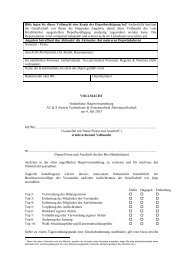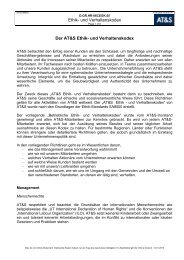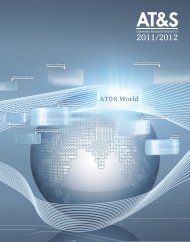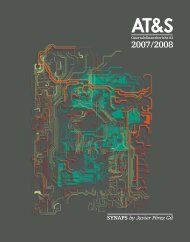AT&S World
AT&S World
AT&S World
Create successful ePaper yourself
Turn your PDF publications into a flip-book with our unique Google optimized e-Paper software.
Consolidated Financial Statements as of 31 March 2011<br />
68<br />
u. New accounting regulations<br />
The IFRS already mandatory at the balance sheet date were<br />
adopted in the preparation of the consolidated financial statements.<br />
At the last balance sheet date, the IASB had already issued<br />
amendments to existing standards as well as new standards<br />
and interpretations, which are mandatory as of 2010/11. These<br />
regulations also have to be applied in the EU and relate to the<br />
following standards:<br />
IFRS 3 “Business combinations” and IAS 27 “Consolidated and<br />
separate financial statements” (Amendments: Recognition of<br />
costs of a business combination, option full goodwill method;<br />
clarifications on step-by-step acquisition and other revision)<br />
A number of additional amendments to standards, as well as<br />
new and amended interpretations were published and adopted<br />
by the European Union. The effects of these regulations on the<br />
consolidated financial statements are not material and therefore<br />
not presented in detail.<br />
The amendments are mandatory for reporting periods beginning<br />
on or after 1 July 2009 and 1 January 2010. Therefore, the Group<br />
will apply these new regulations as of the financial year 2010/11.<br />
The amendments to be applied as of the financial year 2010/11<br />
did not have a material impact on the consolidated financial<br />
statements.<br />
The IASB issued additional standards and amendments to standards<br />
and interpretations that are not yet mandatory in the financial<br />
year 2010/11. The following standards and interpretations<br />
had been adopted by the EU by the time the consolidated financial<br />
statements were prepared and published in the official journal:<br />
IAS 24 “Related party disclosures” (Amends the definition of<br />
a related party and simplifies certain related party disclosure<br />
requirements for government-related entities)<br />
IFRIC 14 “IAS 19 – Prepayments of a minimum funding requirement”<br />
(amendment relevant where there is a minimum<br />
funding requirement and the company makes prepayments of<br />
contributions)<br />
IFRIC 19 “Extinguishing financial liabilities with equity instruments”<br />
(The interpretation clarifies the accounting by an<br />
entity when the terms of a financial liability are renegotiated<br />
and result in the entity issuing equity instruments to a creditor<br />
of the entity to extinguish all or part of the financial liability).<br />
The amendments are mandatory for accounting periods beginning<br />
on or after 1 July 2010 and 1 January 2011. Therefore, the<br />
Group will apply these new regulations as of the financial year<br />
2011/12, which will not have a material impact on the consolidated<br />
financial statements.<br />
Furthermore, the following standard has already been published,<br />
but not yet adopted by the EU:<br />
IFRS 9 “Financial instruments” (This standard is the first step<br />
to replace Standard IAS 39 “Financial instruments: recognition<br />
and measurement” and changes the existing provisions on classification<br />
and measurement of financial assets).<br />
The Standard will only be mandatory for reporting periods beginning<br />
on or after 1 January 2013. From today’s perspective, the<br />
Standard is not expected to have a material impact on the Group’s<br />
financial position and financial performance.<br />
C. Critical accounting estimates and assumptions<br />
The Group uses estimates and assumptions to determine the reported<br />
amounts of assets, liabilities, net sales and expenses, as<br />
well as the disclosure of commitments and contingent assets<br />
and liabilities. All estimates and assumptions are reviewed on<br />
a regular basis and are based on past experiences and additional<br />
factors, including expectations regarding future events<br />
that seem reasonable under given circumstances. In the future<br />
actual results may differ from these estimates, Management believes<br />
that the estimates are reasonable.<br />
Projected benefit obligations<br />
The present value of non-current employee benefits depends on<br />
various factors that are based on actuarial assumptions (refer<br />
to I.B.p. “Employee benefits”).

















